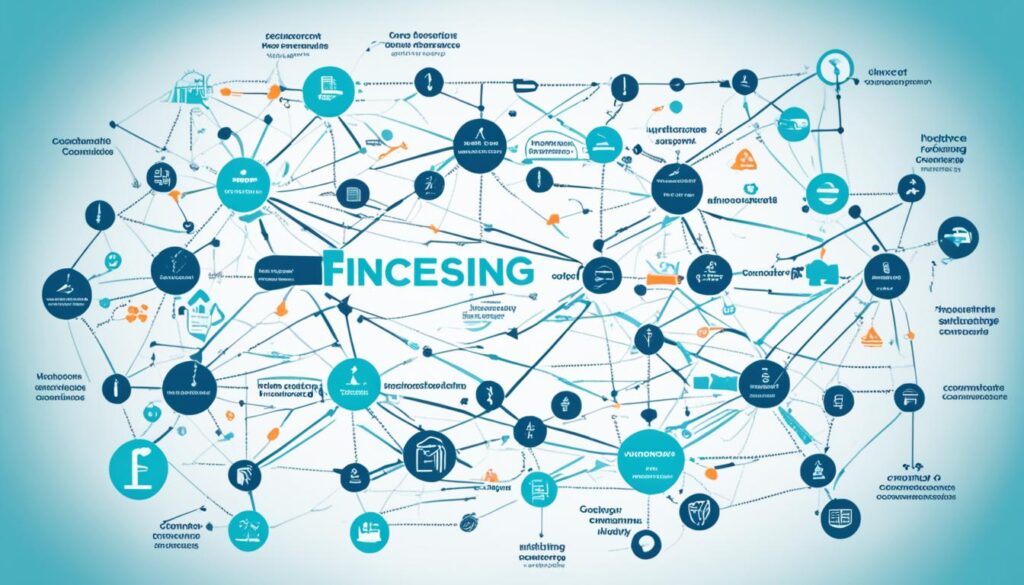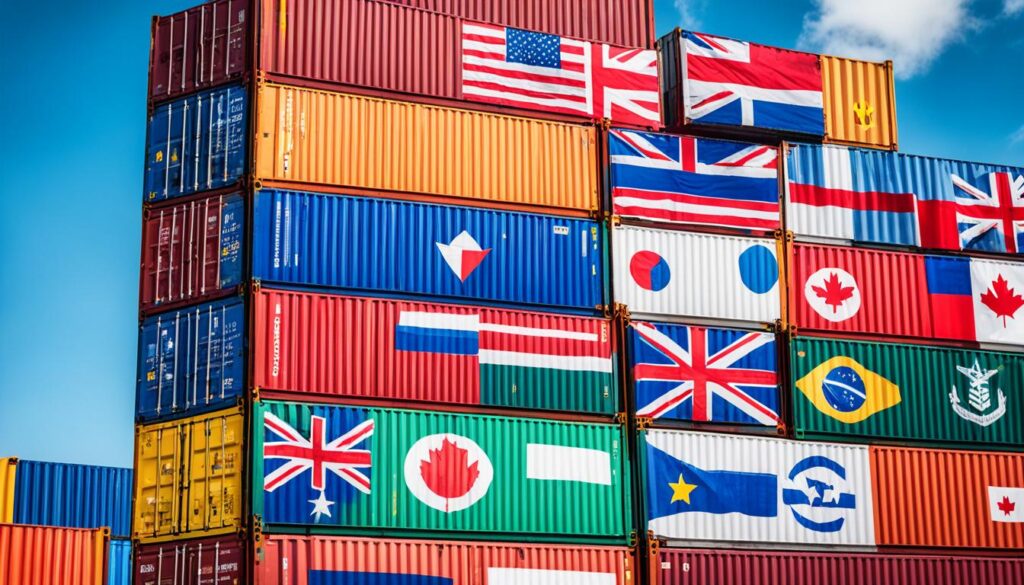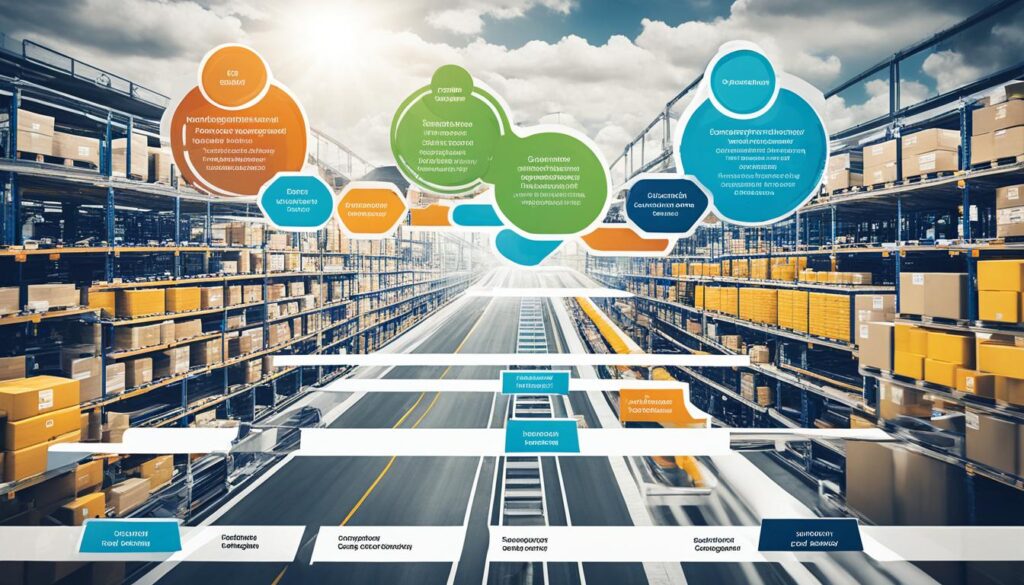Are you an import/export business looking to maximize your growth potential? Discover how trade finance solutions can empower your business and navigate the complexities of global trade.
Trade finance is a vital aspect of import/export businesses, providing funding and support for sustainable growth and success. This article will delve into the fundamental strategies and tools of trade finance, and how they can empower businesses engaged in cross-border commerce. Understanding trade finance is crucial for importers and exporters, as it enables them to navigate the complexities of global trade and maximize their business potential.
Key Takeaways:
- Trade finance plays a crucial role in the success of import/export businesses, mitigating risks, optimizing cash flow, and building trust.
- Essential trade finance instruments include letters of credit, trade credit insurance, and bank guarantees.
- Accessing trade finance requires cultivating strong banking relationships, understanding business needs, and ensuring documentation and compliance.
- Data and AI have the potential to revolutionize trade finance, enhancing efficiency, accuracy, and fraud detection.
- Collaboration between industry players is crucial for driving innovation and efficiency in trade finance.
Understanding Trade Finance
In the realm of international trade transactions, trade finance plays a pivotal role in enabling smooth and secure cross-border commerce. With its diverse range of financial instruments and products, trade finance facilitates transactions while mitigating risks, ensuring proper cash flow, and nurturing trust between trading partners. Let’s delve into the intricacies of trade finance and explore how it empowers importers and exporters in managing their global trade operations.
Trade finance encompasses a wide array of financial instruments tailored specifically to meet the demands of international trade. These instruments include letters of credit, trade credit insurance, bank guarantees, and more. (Keyword: financial instruments) By leveraging these tools, businesses engaged in international trade transactions can navigate the challenges and complexities associated with cross-border commerce.
Letters of credit are a common trade finance instrument, providing security and assurance to both buyers and sellers. They act as a guarantee to the exporter that they will receive payment upon fulfilling the specified conditions outlined in the letter of credit. This creates a foundation of trust between trading partners and ensures a transparent and secure transaction. (Keyword: letters of credit)
Another vital trade finance instrument is trade credit insurance, which safeguards businesses against non-payment risks arising from commercial or political events. By insuring their trade receivables, businesses protect themselves from potential losses and maintain a healthy cash flow. This instrument also enhances their creditworthiness, making it easier to secure financing and establish long-term partnerships. (Keyword: trade credit insurance)
Bank guarantees are yet another critical component of trade finance. These guarantees offer a safety net to the beneficiary in case the importer defaults on their payment obligations. By providing financial security to the seller, bank guarantees foster confidence, enabling businesses to engage in international trade transactions with peace of mind. (Keyword: bank guarantees)
Trade finance instruments such as letters of credit, trade credit insurance, and bank guarantees not only facilitate international trade transactions but also empower businesses by mitigating risks, ensuring cash flow, and fostering trust between trading partners.
Understanding trade finance is indispensable for importers and exporters aiming to effectively navigate the complexities of global trade. By comprehending the nuances of financial instruments, trade finance products, and their applications, businesses can make informed decisions, optimize their international trade operations, and seize opportunities for growth.

Through the effective utilization of trade finance tools, businesses can unlock their true potential in the global marketplace. In the following section, we will delve into the significance of trade finance for import/export businesses and explore how it helps mitigate risks, optimize cash flow, and foster trust in international trade transactions. (Keywords: trade finance, international trade transactions)
Importance of Trade Finance for Import/Export Businesses
Trade finance is a vital lifeline for import/export businesses, offering essential support and enabling sustainable growth and success in the global marketplace. With the complexities and uncertainties of international trade, trade finance plays a crucial role in mitigating risks, optimizing cash flow, and building trust between trading partners.
Import/export businesses face numerous risks in their cross-border transactions, including currency fluctuations, non-payment by buyers, and geopolitical uncertainties. These risks can have a significant impact on the financial health and stability of a business. Trade finance instruments provide a safety net by offering various risk mitigation strategies, such as trade credit insurance and bank guarantees. These instruments protect businesses from potential losses, ensuring that they can conduct international trade with confidence.
Cash flow is the lifeblood of any business, and import/export businesses are no exception. The import/export cycle involves complex supply chains, extended payment terms, and fluctuating demand. Trade finance instruments address cash flow challenges by providing liquidity when needed the most. For example, importers can benefit from trade finance solutions that offer pre-shipment financing, allowing them to pay suppliers upfront. Exporters, on the other hand, can leverage post-shipment financing to bridge the gap between delivery and payment. These financing options ensure smooth cash flow throughout the import/export cycles, enabling businesses to operate efficiently.
Trust is essential in any business relationship, especially when it comes to international trade. Trading partners need assurance that payments will be made promptly and in accordance with agreed-upon terms. Trade finance instruments such as letters of credit provide this reassurance by guaranteeing payment to the exporter once specific conditions are met. This payment security builds trust between trading partners, encouraging further collaboration and facilitating long-term business relationships.

Import/export businesses cannot underestimate the importance of trade finance in navigating the global trade landscape successfully. By mitigating risks, optimizing cash flow, and fostering trust, trade finance empowers businesses to seize opportunities in the global market and achieve sustainable growth.
Essential Trade Finance Instruments
When engaging in international trade transactions, businesses can leverage several essential trade finance instruments to optimize their operations and ensure smooth and secure transactions. These instruments provide crucial financial support and risk mitigation measures, enhancing the overall efficiency and effectiveness of cross-border commerce. The three primary trade finance instruments that play a critical role in facilitating international trade are: letters of credit, trade credit insurance, and bank guarantees.
Letters of Credit
One of the key trade finance instruments is a letter of credit (LC). An LC acts as a guarantee from a buyer’s bank to an exporter, ensuring payment upon the fulfillment of specific conditions outlined in the LC. This instrument minimizes payment risks for exporters and provides increased confidence to both buyers and sellers. In an LC arrangement, the buyer’s bank commits to make payment on behalf of the buyer once the exporter meets the required obligations, such as providing proof of shipment or meeting quality standards. By utilizing letters of credit, businesses can navigate the challenges of international trade and foster trust between trading partners.
Trade Credit Insurance
Trade credit insurance is a trade finance instrument that protects businesses against the risk of non-payment arising from commercial or political events. By insuring their receivables, businesses can effectively manage their cash flow and mitigate the impact of non-payment. Trade credit insurance provides coverage against a range of risks, including buyer insolvency, protracted default, and political risks such as trade sanctions or political instability. This instrument not only safeguards businesses financially but also enables them to confidently conduct international trade, knowing that they are protected against potential losses.
Bank Guarantees
Bank guarantees are another essential trade finance instrument that provides assurance to the beneficiary in the event of default by the importer. In a bank guarantee arrangement, the issuing bank guarantees payment to the beneficiary (usually the seller or exporter) should the importer fail to fulfill their contractual obligations. This financial guarantee instills confidence in trading partners and ensures contractual compliance. Bank guarantees are commonly used in various types of international trade transactions, including procurement contracts, construction projects, and sales of goods or services. By utilizing bank guarantees, businesses can mitigate the risks associated with default and secure the successful completion of their trade agreements.
By leveraging these essential trade finance instruments, businesses can optimize their international trade transactions, minimize risks, and foster trust and confidence among trading partners. Whether it’s the use of letters of credit, trade credit insurance, or bank guarantees, each instrument plays a crucial role in facilitating smooth and secure cross-border commerce.

Strategies for Accessing Trade Finance
Accessing trade finance requires businesses to employ specific strategies. To effectively access the diverse range of trade finance solutions available, cultivating strong banking relationships is crucial. Trusted banking partners can provide tailored trade finance products that cater to the unique needs of your business.
Understanding the specific needs of your business is essential in selecting the right trade finance instruments. Whether it’s letters of credit, trade credit insurance, or bank guarantees, choosing the appropriate financial tools will align with your trade cycles and risk appetites, ensuring optimal support for your operations.
Additionally, optimizing documentation and ensuring compliance with regulations are vital steps in accessing trade finance. Accurate and comprehensive documentation not only streamlines the approval process but also demonstrates your commitment to compliance, increasing the likelihood of approval for trade finance facilities.
By implementing these strategies, businesses can effectively access the trade finance solutions that best suit their needs, empowering them to grow and flourish in the global marketplace.

Utilizing Data and AI in Trade Finance
Data and artificial intelligence (AI) are driving a revolution in the trade finance industry. By harnessing the power of data and AI technologies, trade finance providers can address pain points that have long plagued the industry, while also adding significant value to their products and services. The integration of data and AI brings numerous benefits, including improved efficiency, accuracy, transparency, and fraud detection.
One of the most significant advantages of utilizing data and AI in trade finance is the ability to tackle time-consuming processes, such as invoice management. These manual tasks often result in delayed payments and increased administrative burden. However, with AI-powered systems, invoice processing can be streamlined, automating repetitive tasks and reducing errors. This not only saves time but also enhances overall operational efficiency, allowing businesses to focus on core activities.
Moreover, data and AI contribute to the optimization of credit underwriting and risk assessment in trade finance. By analyzing vast datasets and leveraging advanced algorithms, AI systems can provide more accurate risk evaluations, enabling lenders to make informed decisions. This leads to fairer credit assessments and increased access to trade finance for businesses that may have otherwise been overlooked.
“Data-driven insights and AI technologies revolutionize the way we understand and manage risks in trade finance, allowing us to make more informed decisions based on real-time information and predictive analytics.” – John Smith, Chief Risk Officer at Trade Finance Solutions Inc.
In addition to risk assessment, the use of data and AI facilitates enhanced transparency in trade finance transactions. Blockchain technology, for example, enables secure and transparent digital records of trade-related information, creating a single source of truth across multiple parties. This greatly reduces the potential for fraud and enhances trust among trading partners.
Challenges and Considerations
While the benefits of data and AI in trade finance are vast, there are several challenges that need to be addressed. Data privacy and information security are critical concerns, as trade finance involves sensitive financial information. Robust security measures must be implemented to protect against unauthorized access and data breaches.
Additionally, the reliance on technology raises questions about system integrity and potential disruptions. Ensuring the availability and reliability of AI systems is crucial to maintain uninterrupted trade finance operations. This requires ongoing monitoring, maintenance, and contingency plans to mitigate any potential downtime or technical issues.
Furthermore, the adoption of data and AI technologies may pose challenges for some organizations. Limited technological infrastructure, lack of skilled professionals, and resistance to change can hinder the implementation and integration of these advanced systems. However, with proper training, strategic planning, and industry collaboration, these challenges can be overcome.
Despite the challenges, the transformative potential of data and AI in trade finance is undeniable. The adoption of these technologies is reshaping the industry, revolutionizing processes, and creating new opportunities for growth and efficiency.
Collaboration Between Industry Players
Collaboration plays a pivotal role in driving innovation and efficiency in the trade finance landscape. By joining forces, industry players can unlock new opportunities and overcome challenges together. In the realm of trade finance, collaboration between banks, fintech startups, e-commerce companies, and logistics companies yields tangible benefits for all parties involved.
When banks collaborate with fintech startups, they can leverage advanced analytics capabilities and tap into established infrastructures. This collaboration enables them to enhance their trade finance offerings and provide tailored solutions to import/export businesses. By harnessing the power of technology and innovation, collaborative efforts between banks and fintechs pave the way for more efficient and customer-centric trade finance services.
E-commerce companies and logistics companies also play a crucial role in trade finance. Their collaboration results in a symbiotic relationship that facilitates the optimization of supply chain finance. E-commerce companies contribute valuable transactional data, which can be leveraged by logistics companies to streamline processes and improve overall efficiency. The availability of accurate and real-time data empowers logistics companies to identify bottlenecks, optimize inventory management, and reduce costs.
“Collaboration between industry players facilitates comprehensive solutions and improves the overall efficiency and effectiveness of trade finance.”
Establishing strategic partnerships and fostering collaboration are key strategies for creating a robust trade finance ecosystem. By sharing expertise, integrating data sets, and co-creating new solutions, industry players can collectively address the evolving needs of import/export businesses and drive sustainable growth.
Benefits of Collaboration
The collaboration between banks, fintechs, e-commerce companies, and logistics companies in the trade finance space offers several key advantages:
- Access to advanced analytics and technology-driven solutions
- Enhanced customer experience through tailored trade finance services
- Optimized supply chain finance and improved operational efficiency
- Increased trust and transparency among trading partners
- Expanded market reach and access to new customer segments
Case Study: Trade Finance Collaboration in Action
To illustrate the transformative power of collaboration in trade finance, let’s take a look at a real-world example:
ABC Bank, a leading financial institution, partnered with XYZ Fintech, a technology-driven startup specializing in trade finance solutions. By combining ABC Bank’s extensive banking network and expertise with XYZ Fintech’s innovative technology platform, the collaboration resulted in a groundbreaking trade finance product.
The new product utilized artificial intelligence and machine learning algorithms to automate the trade finance process, reducing paperwork and turnaround time. Through this collaboration, ABC Bank was able to revolutionize its trade finance offerings, providing faster and more efficient services to import/export businesses. The collaboration also enabled XYZ Fintech to access a broader customer base and leverage ABC Bank’s established reputation in the industry.
Overall, this collaboration demonstrated how the collective expertise and resources of industry players can drive meaningful change and deliver tangible benefits to the world of trade finance.

| Key Players | Benefits |
|---|---|
| Banks | Access to advanced analytics and technology-driven solutions |
| Fintech Startups | Enhanced customer experience through tailored trade finance services |
| E-commerce Companies | Optimized supply chain finance and improved operational efficiency |
| Logistics Companies | Increased trust and transparency among trading partners |
Collaboration between industry players is the bedrock of innovation and efficiency in trade finance. By leveraging each other’s strengths and resources, banks, fintechs, e-commerce companies, and logistics companies can deliver comprehensive solutions and drive the evolution of trade finance.
The Future of Data and AI in Trade Finance
The future of trade finance is poised for transformation with the advancements in data and artificial intelligence (AI) technologies. The integration of data and AI in trade finance holds immense potential for revolutionizing the industry and driving its growth towards new horizons.
Data and AI technologies have the power to revolutionize credit underwriting in trade finance. By leveraging vast amounts of data and analyzing it through AI algorithms, trade finance providers can make more informed credit decisions. This enables fairer trade finance processes and enhances the overall efficiency of credit assessment.
Collaboration and standardization among industry players are crucial in maximizing the benefits of data-driven trade finance. By sharing data and insights, banks, fintechs, and other stakeholders can collectively innovate and develop comprehensive solutions. Standardization ensures seamless interoperability and connectivity, enabling smoother transactions and enhanced customer experiences.
The future presents numerous opportunities for automation and digitization in trade finance. With the integration of AI technologies, manual processes can be streamlined, reducing paperwork and increasing operational efficiency. Automation also minimizes errors and accelerates transaction processing, leading to quicker turnaround times and improved customer satisfaction.
Nevertheless, the future of data and AI in trade finance is not without its challenges. Data privacy, security, and regulatory compliance are critical considerations that must be addressed to ensure a trustworthy and secure environment for data-driven trade finance. Robust measures and stringent protocols are necessary to safeguard sensitive information and protect against potential cyber threats.
Despite these challenges, the opportunities presented by data and AI in trade finance are vast. By overcoming obstacles through collaborative efforts and strategic partnerships, the trade finance industry can harness the full potential of data and AI technologies. The future holds promise for enhanced efficiency, greater transparency, and improved risk assessment in trade finance operations.
Key Takeaways:
- Data and AI technologies enable more informed credit decisions and fairer trade finance processes.
- Collaboration and standardization among industry players maximize the benefits of data-driven trade finance.
- Automation and digitization offer opportunities for improved efficiency and customer experiences.
- Data privacy, security, and regulatory compliance are challenges that need to be addressed.
- The future of trade finance holds immense potential for transformation through data and AI.
Market Outlook for Trade Finance
The trade finance market is poised for steady and robust growth, fueled by the increasing demand for environmentally sustainable products and the integration of advanced technology. With a focus on innovation and growth, both domestic and international trade finance sectors are presenting significant opportunities for businesses.
Market research reports provide valuable insights into the trade finance market, offering the necessary information on market size, trends, and potential scenarios. By understanding the market landscape and dynamics, businesses can effectively identify opportunities and assess risks in the trade finance industry.
As the world shifts towards sustainable practices, businesses that align their trade finance solutions with environmentally friendly initiatives are likely to thrive. Utilizing advanced technology, such as artificial intelligence and blockchain, can enhance efficiency, transparency, and security in trade finance operations.
In addition, the ongoing digitization of trade processes and the rise of e-commerce are shaping the trade finance market. These trends are driving the need for seamless integration, faster transactions, and optimized supply chain finance solutions.






